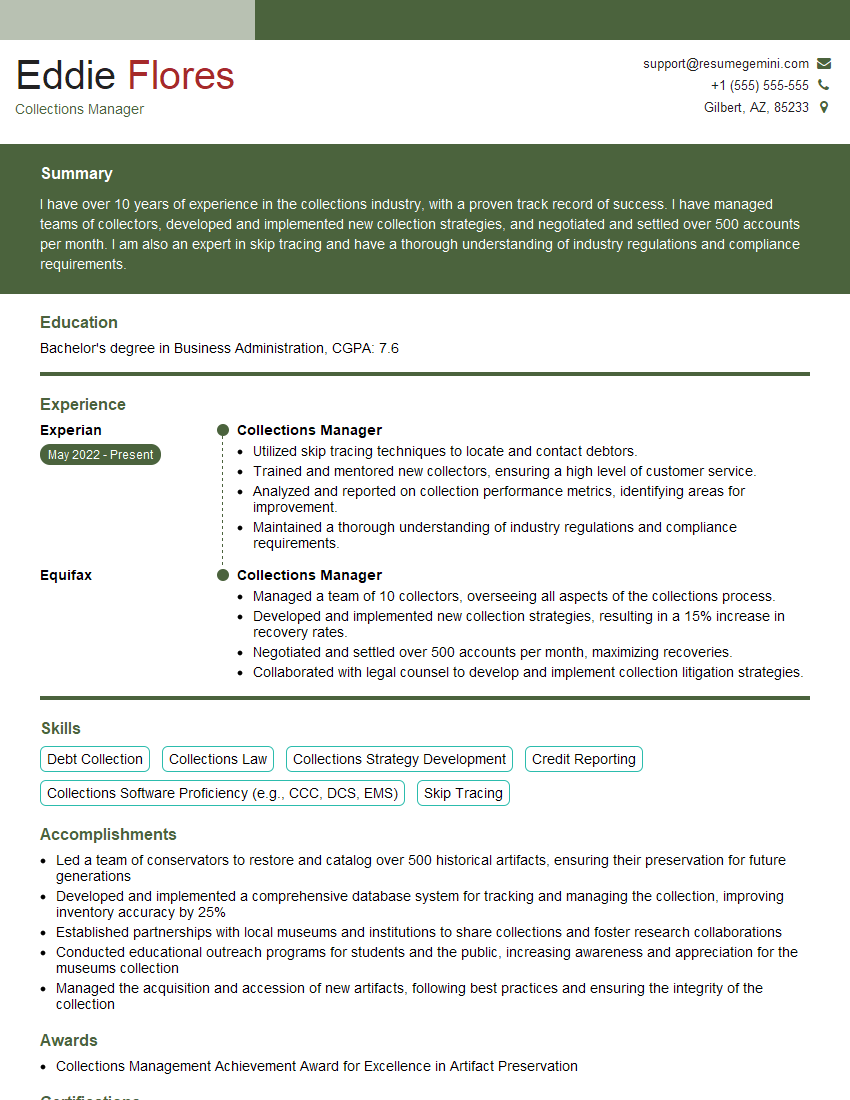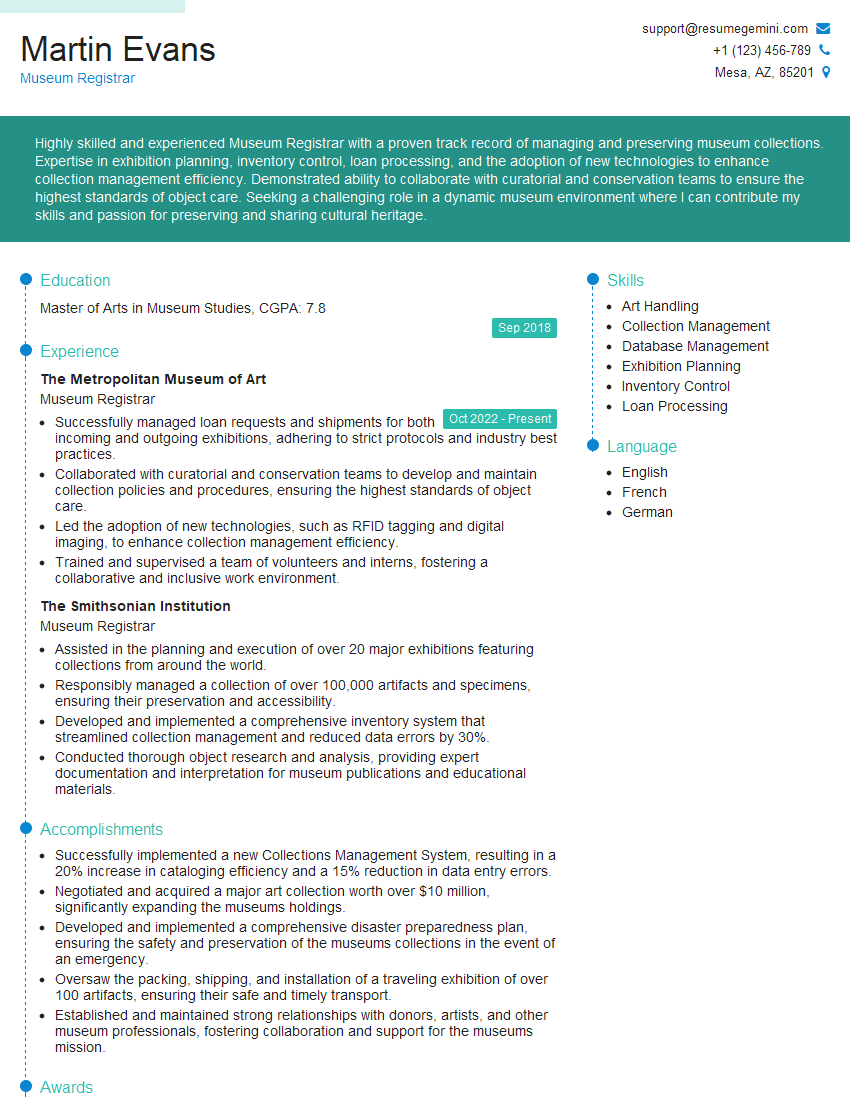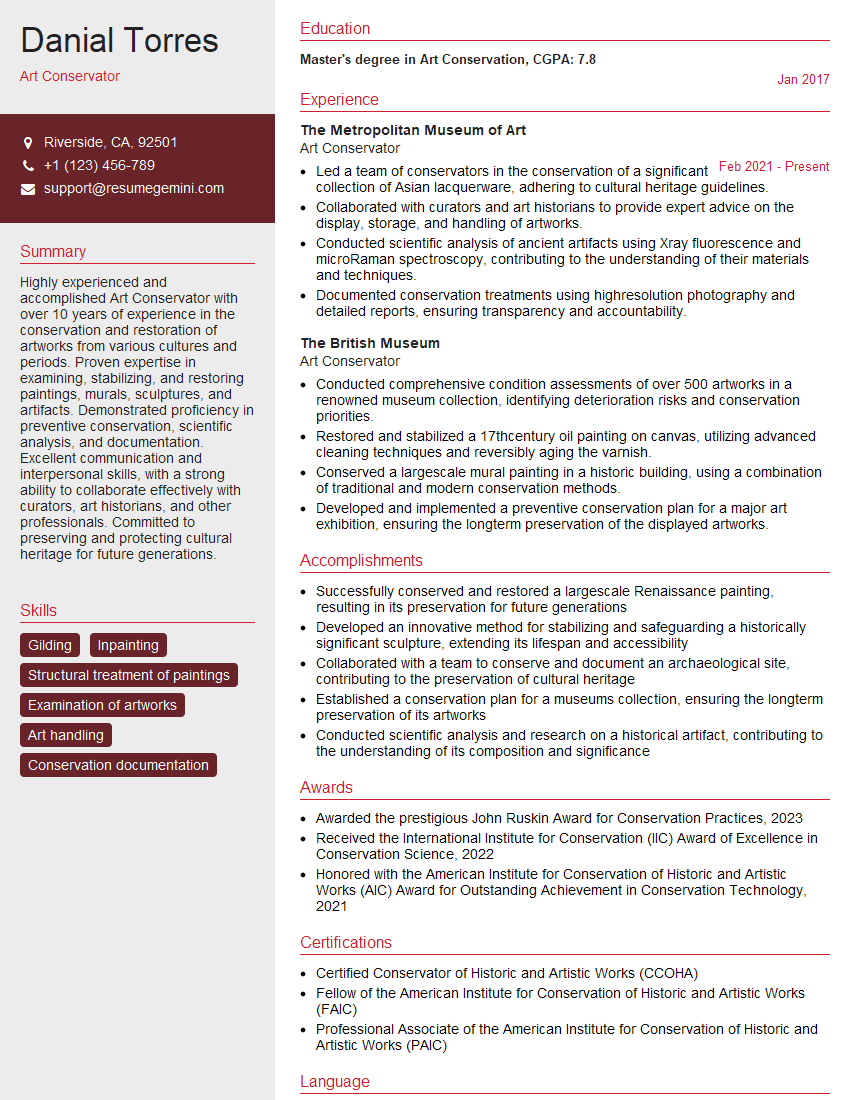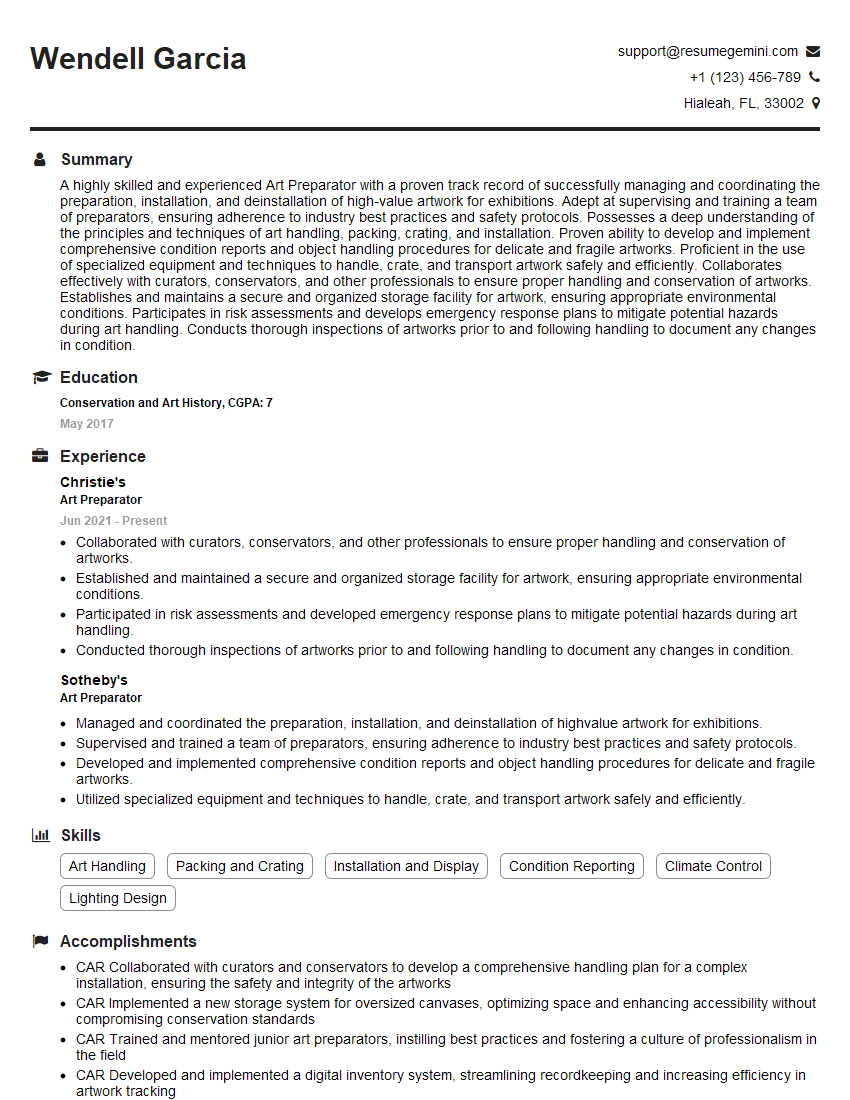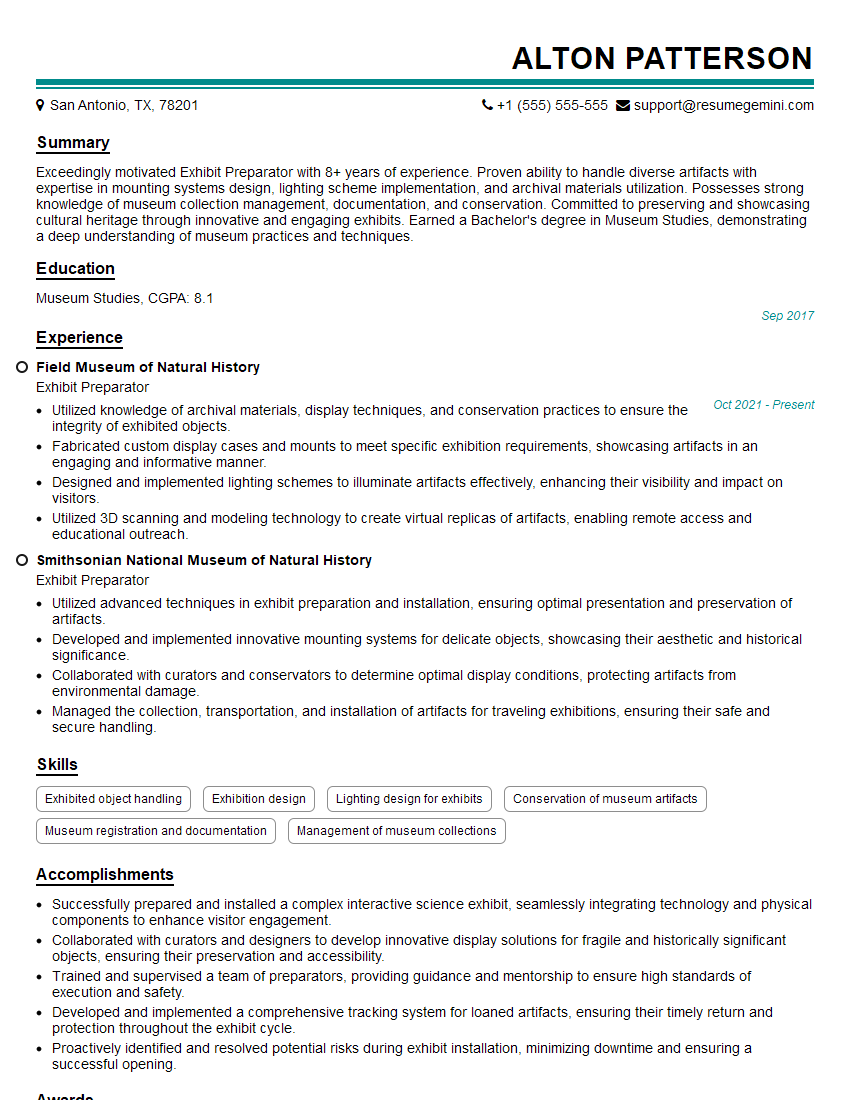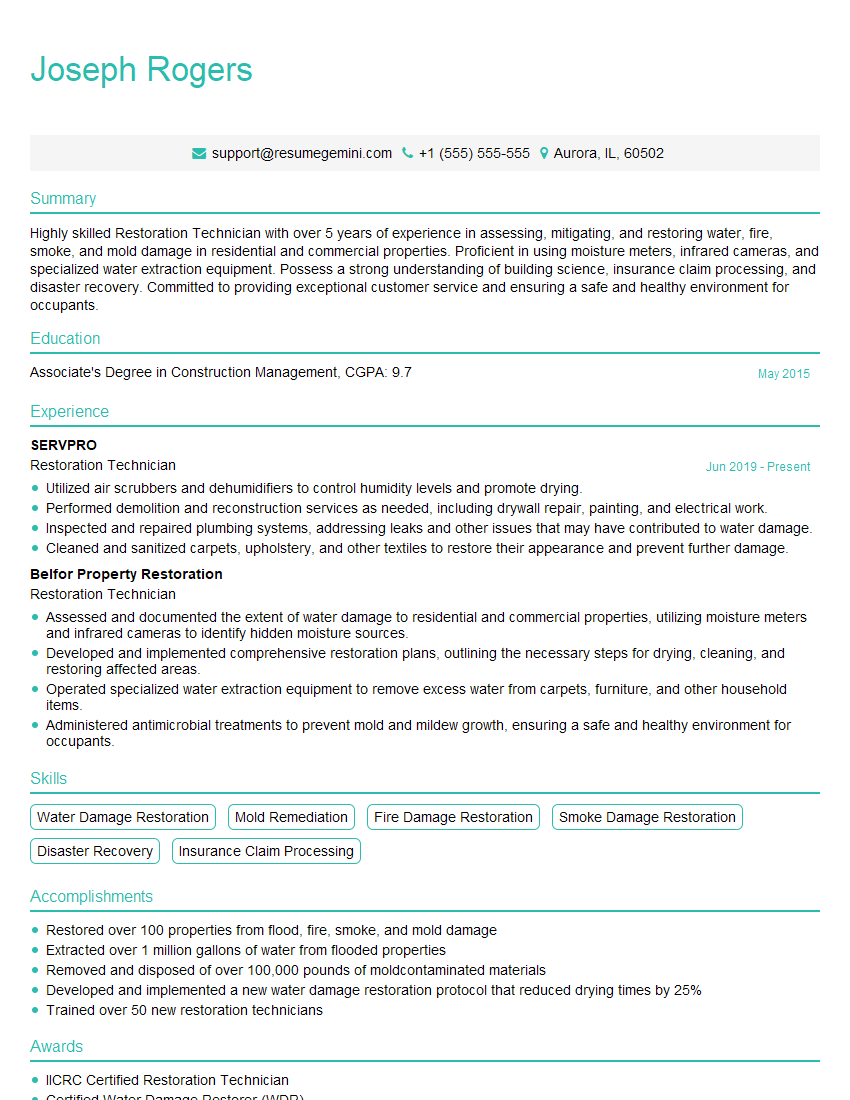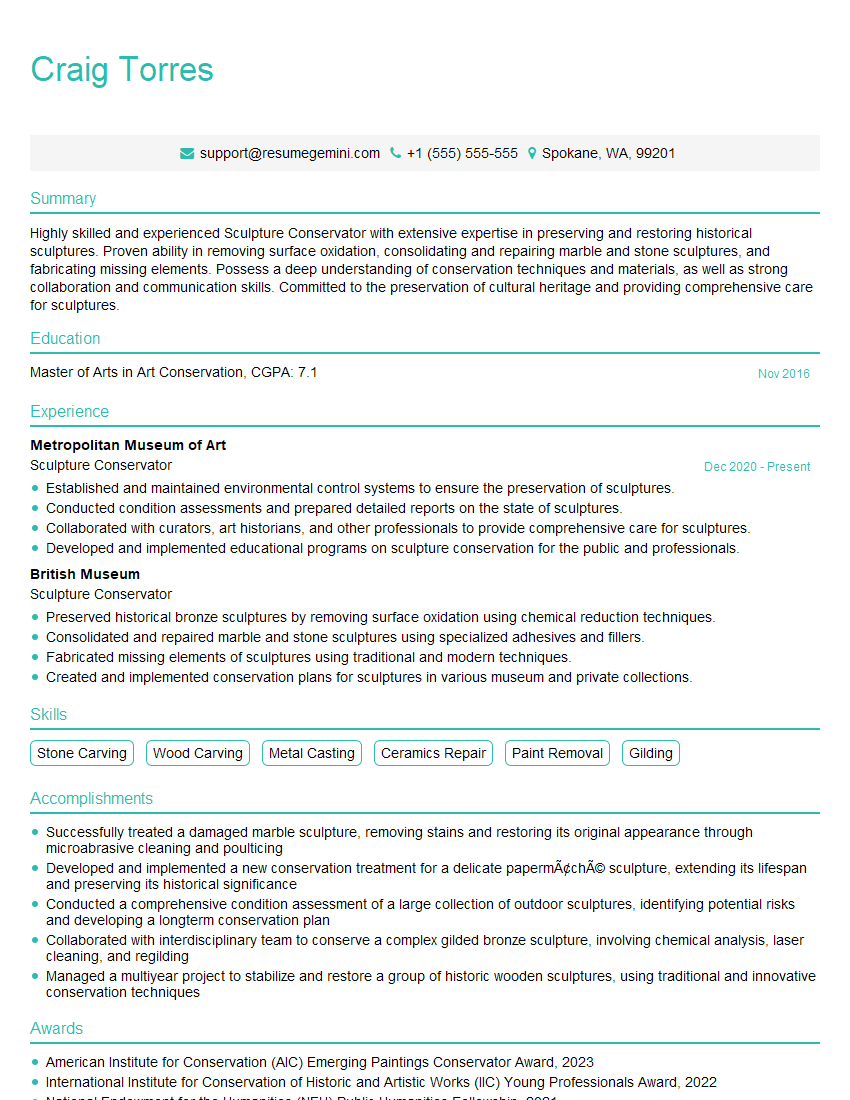Are you ready to stand out in your next interview? Understanding and preparing for Performing maintenance and repairs on existing artwork, such as tightening screws and replacing wires interview questions is a game-changer. In this blog, we’ve compiled key questions and expert advice to help you showcase your skills with confidence and precision. Let’s get started on your journey to acing the interview.
Questions Asked in Performing maintenance and repairs on existing artwork, such as tightening screws and replacing wires Interview
Q 1. Describe your experience with repairing damaged canvas paintings.
Repairing damaged canvas paintings requires a delicate touch and a thorough understanding of materials. The approach depends heavily on the type and extent of the damage. Minor tears can often be mended using a combination of high-quality linen adhesive and careful stitching, matching the weave of the original canvas as closely as possible. Larger tears or significant losses may necessitate inpainting – a process where the artist meticulously recreates the lost areas using pigments to blend seamlessly with the surrounding paint. This is an advanced technique requiring artistic skill and patience.
For example, I once worked on a 19th-century landscape where a large section of the canvas had been torn. After careful cleaning and stabilization, I used a high-quality Japanese tissue to support the tear from the back, then meticulously inpainted the missing section, using archival-quality paints to replicate the original style and texture. The result was a nearly invisible repair that preserved the artwork’s integrity.
Q 2. How would you address a loose screw on a sculptural element?
Addressing a loose screw on a sculptural element is a straightforward but crucial task, requiring attention to detail. First, I’d assess the screw’s condition and the material of both the screw and the sculpture. A simple tightening might suffice if the threads are intact and the surrounding wood or metal isn’t damaged. If the screw is stripped or damaged, I’d carefully remove it, cleaning the hole thoroughly. Then, I’d choose a replacement screw of the correct size and material, ensuring it’s compatible with the sculpture’s material to avoid further damage. I’d then apply a small amount of appropriate adhesive (like wood glue for wooden sculptures) before inserting the new screw, ensuring a secure and stable fit.
In one instance, I repaired a loose screw on a delicate bronze sculpture. The original screw was corroded and damaged. I carefully replaced it with a stainless steel screw of the correct diameter and length, using a tiny amount of epoxy resin to secure it. This prevented further corrosion and ensured the sculpture’s stability.
Q 3. What techniques do you use to safely replace wires in a delicate artwork?
Replacing wires in a delicate artwork requires extreme care and precision. I always start by documenting the existing wiring, photographing it thoroughly, and noting the type and gauge of wire used. Then, I carefully disconnect the old wires, using small, specialized tools to avoid damaging the artwork. The process involves gently separating the wires from any fragile components, such as the terminals or connectors attached to the artwork. Once the old wires are removed, I carefully clean the connection points before installing the new wires, using a wire gauge that matches the original as closely as possible. I use archival-quality, acid-free wire and ensure all connections are secure and insulated to prevent short circuits. The new wires should be carefully routed and secured to minimize stress on the artwork.
For example, replacing the wiring in an antique lamp required meticulous attention to the fragile ceramic base. I used very fine wire and small needle-nose pliers to ensure I didn’t chip or crack the ceramic during the process.
Q 4. Explain your process for cleaning and preserving fragile artwork.
Cleaning and preserving fragile artwork is a critical aspect of conservation. It’s paramount to begin with a thorough examination to identify the artwork’s materials and the nature of the soiling. This informs the cleaning method. For delicate works, I typically employ non-invasive techniques, such as using soft brushes and conservation-grade solvents to remove surface dust and grime. Compressed air can be used for delicate areas to carefully remove loose particles. The use of distilled water is often preferred to minimize the risk of mineral deposits. Excessive cleaning should be avoided to prevent damage. Post-cleaning, the artwork is carefully monitored and any necessary further interventions are documented.
In a recent project, I cleaned a watercolor painting that had significant surface dirt. I used a soft, sable brush and deionized water, applying it very gently in small areas to avoid damaging the delicate watercolor pigments. The results were impressive, with the colors regaining their vibrancy without any damage to the painting.
Q 5. How would you handle a cracked frame?
Handling a cracked frame depends on the severity and location of the crack. Small cracks can often be repaired using appropriate wood glue and clamps. The surfaces should be clean and dry before applying glue. For more significant cracks or breaks, specialized woodworking techniques may be necessary. This could involve using wood filler to consolidate broken pieces, followed by careful reassembly and reinforcement with consolidants. In some cases, particularly with antique frames, it may be necessary to consult a specialist wood conservator. The goal is to stabilize the frame and prevent further deterioration, maintaining its structural integrity and aesthetic appeal.
I recall a project where an antique gilded frame had a significant crack. I used a specialized wood glue designed for antique frames, carefully aligning the pieces, and clamping them for 24 hours. Following the glue drying, I then applied a consolidant to strengthen the repaired area. The end result ensured the frame’s stability.
Q 6. What types of adhesives are appropriate for artwork repair?
The choice of adhesive for artwork repair is crucial and depends on various factors including the materials involved and the type of damage. Archival-quality adhesives are essential to ensure the repair’s longevity and prevent further damage. Common choices include: animal-hide glues (for wooden frames or certain types of paper), polyvinyl acetate (PVA) emulsions (a versatile adhesive for various materials), and methyl cellulose (for delicate paper and textiles). It is essential to test any adhesive on a hidden area to ensure compatibility and avoid unwanted reactions. The adhesive must be reversible if possible, allowing for future removal should the need arise.
For instance, when mending a tear in a delicate watercolor, I would choose a high-quality, reversible methyl cellulose adhesive, ensuring it’s applied sparingly and accurately to minimize any potential damage to the artwork.
Q 7. How do you determine the best method for repairing a tear in a painting?
Determining the best method for repairing a tear in a painting depends on several factors: the size and location of the tear, the painting’s material (canvas, paper, etc.), and the age and condition of the artwork. Small tears can sometimes be repaired with archival-quality adhesive, applied carefully to the back of the tear. For larger tears or tears in fragile materials, more complex techniques may be required, such as lining the painting with a supportive backing material or using Japanese tissue to support the tear from the reverse. Inpainting might be necessary to restore the lost paint layer. The process requires a high level of skill and precision, ensuring that the repair is both structurally sound and aesthetically pleasing.
I once encountered a significant tear in an oil painting on canvas. After carefully cleaning the tear, I used a combination of linen adhesive and Japanese tissue to support the tear from the back. This was followed by a very careful inpainting, subtly matching the original style and texture.
Q 8. Describe your experience working with various types of framing materials.
My experience encompasses a wide range of framing materials, from traditional wood frames – including hardwoods like oak and mahogany, and softwoods like pine – to more contemporary options such as metal (aluminum, steel), and even plastic or composite materials. I’m familiar with the various joinery techniques used in frame construction, such as mitered joints, rabbet joints, and spline joints. Understanding these is crucial for effective repairs, as knowing the construction method informs the repair approach. For example, a loose mitered joint might require re-gluing and clamping, while a broken spline would necessitate replacement. I also have extensive experience working with different glazing materials, including glass (standard and UV-protective), acrylic, and museum-grade glazing materials which offer enhanced protection against UV damage and offer a safer alternative in some cases. The selection of the right framing material is always considered in relation to the artwork itself, considering factors like weight, size, and fragility of the artwork.
Q 9. How familiar are you with different types of artwork materials (e.g., oil paint, watercolor, bronze)?
My familiarity with artwork materials is extensive, covering a broad spectrum of media. I’m adept at handling oil paintings, understanding the complexities of the paint layers and the potential for cracking or flaking. With watercolors, I understand their delicate nature and the specific considerations needed to avoid damage during cleaning or repair. I have experience working with sculptures made from various materials, including bronze, where I’m knowledgeable about patination and the potential for corrosion. I also have experience with works on paper – prints, drawings, and photographs – understanding the challenges presented by their sensitivity to light, humidity, and handling. The knowledge of the material informs the choice of cleaning method and repair technique. For instance, a bronze sculpture might need cleaning with specialized bronze cleaning solutions, while a watercolor might only tolerate very gentle, dry cleaning.
Q 10. What safety precautions do you take when handling potentially hazardous materials?
Safety is paramount in my work. When handling potentially hazardous materials, I adhere to strict protocols. This includes using appropriate personal protective equipment (PPE) such as gloves (nitrile for most applications, but others like cotton for handling delicate items), eye protection, and respirators when dealing with solvents, paints, or potentially toxic materials. I always work in a well-ventilated area, or utilize local exhaust ventilation when appropriate. I properly label and store all hazardous materials according to safety data sheets (SDS), ensuring they’re kept away from heat sources and out of reach of unauthorized personnel. I’m also trained in the proper disposal of hazardous waste, ensuring compliance with all environmental regulations. For example, when working with lead-based paints (common in older artworks), I would wear a respirator and work slowly, carefully containing any dust generated. The same methodical approach would be used when handling solvents like turpentine or mineral spirits.
Q 11. Explain your understanding of preventative conservation measures.
Preventative conservation focuses on minimizing the risk of damage to artwork over time. It’s about proactive measures, rather than reactive repairs. This includes proper environmental control – maintaining stable temperature and humidity levels to prevent warping, cracking, and fading. Appropriate storage is key, including protection from light (especially UV light), insects, and dust. Regular inspections are crucial for early detection of potential problems; for example, checking for loose components, signs of pest infestation, or changes in the artwork’s condition. Proper handling and display practices also play a vital role, using appropriate supports and minimizing handling as much as possible. For example, if a painting is showing signs of fading, repositioning it away from direct sunlight would be a preventative measure. Regular dusting and cleaning, using appropriate methods for the artwork’s material, are also key components.
Q 12. How do you document your repair work?
Documentation is vital for maintaining a clear record of repairs and conservation treatments. I use a combination of methods. Firstly, I create a detailed written report that outlines the condition of the artwork before treatment, the specific repairs undertaken, the materials used, and any challenges encountered. This report also includes photographs documenting the artwork’s condition at different stages of the process – before, during and after repair. I use high-resolution digital photography and often include close-up shots to highlight details. Sometimes, I may also include videos to document particularly complex repairs or demonstrate specific techniques. All documentation is meticulously dated and stored securely for future reference, creating a comprehensive history of the artwork’s conservation. The goal is to provide a detailed and transparent record of the work performed that is easily accessible for future conservators or owners.
Q 13. Have you ever worked with archival materials? If so, what are they?
Yes, I frequently work with archival materials. These are materials specifically designed to minimize degradation and ensure the longevity of artwork and documents. Common archival materials include acid-free paper and board, lignin-free papers (lignin is a component of wood pulp that can cause yellowing and embrittlement), archival-quality mat boards and frames, and acid-free adhesives. I also use archival-quality storage containers and enclosures to protect artwork from environmental damage. The use of these materials is crucial for ensuring the long-term preservation of artworks, as the materials themselves won’t damage or negatively interact with the artwork over time.
Q 14. Describe a time you had to troubleshoot an unexpected problem during an artwork repair.
I once encountered a challenging situation while repairing an antique oil painting. The painting had significant cracking in the paint layer, and during the initial stages of the repair, a small area of paint unexpectedly detached. My initial approach, using a traditional consolidant, wasn’t effective in stabilizing this area. I had to troubleshoot the problem and determine the underlying cause of the detachment. Through careful examination using magnification, I discovered that the original canvas had sustained previous damage, and there was a hidden void under the paint surface that was previously undetected. My solution involved carefully injecting a small amount of a microcrystalline wax consolidant into the void to stabilize it from the backside, then consolidating the paint surface with a more suitable consolidant. This required meticulous patience and a shift in my repair strategy. This experience highlighted the importance of thorough assessment before starting any repair and the need to adapt to unexpected challenges through careful observation and problem-solving.
Q 15. How would you identify and address potential pest infestations in an art collection?
Identifying and addressing pest infestations in an art collection requires a multi-pronged approach focusing on prevention and eradication. Early detection is crucial. Regular, thorough inspections are paramount – looking for signs like droppings, webbing, insect fragments, or actual insects themselves. Different pests require different strategies.
Prevention: This includes maintaining a clean and well-ventilated environment. Regular vacuuming and dusting are key, especially in hard-to-reach areas. Using pheromone traps to monitor pest activity can provide early warnings. Proper storage, keeping artworks away from walls and each other to allow for air circulation, helps too. We should also implement pest-proofing measures by sealing cracks and crevices to prevent entry.
Eradication: If an infestation is discovered, immediate action is required. The type of pest dictates the method. For example, a professional pest control company specializing in art conservation should be called in. They can identify the pest and use appropriate, art-safe methods. These could include targeted treatments with low-toxicity insecticides, freezing, or even the use of oxygen deprivation chambers for sensitive items. Never attempt aggressive DIY solutions that could harm the artwork.
For instance, I once discovered a small silverfish infestation in a client’s collection of antique books. Instead of using harsh chemicals, we opted for a combination of freezing the affected books and introducing pheromone traps to monitor the situation. The integrated pest management strategy worked wonderfully.
Career Expert Tips:
- Ace those interviews! Prepare effectively by reviewing the Top 50 Most Common Interview Questions on ResumeGemini.
- Navigate your job search with confidence! Explore a wide range of Career Tips on ResumeGemini. Learn about common challenges and recommendations to overcome them.
- Craft the perfect resume! Master the Art of Resume Writing with ResumeGemini’s guide. Showcase your unique qualifications and achievements effectively.
- Don’t miss out on holiday savings! Build your dream resume with ResumeGemini’s ATS optimized templates.
Q 16. What is your experience with environmental monitoring in art storage and display areas?
Environmental monitoring is fundamental to preserving artwork. Fluctuations in temperature, relative humidity, and light levels can cause significant damage. I have extensive experience utilizing various monitoring systems. These systems range from simple, hand-held devices that measure temperature and humidity to sophisticated, computerized systems that provide real-time data and alerts.
These systems allow for continuous monitoring of storage and display areas. This data is crucial for preventing damage. For example, sudden spikes in temperature or humidity can cause warping, cracking, or mold growth on canvases or paper. Similarly, prolonged exposure to ultraviolet (UV) light can fade pigments. Therefore, the data collected allows us to proactively adjust environmental controls—HVAC systems, dehumidifiers, specialized lighting—to maintain optimal conditions.
In a recent project, I implemented a computerized monitoring system in a museum’s storage facility. This system provided continuous data logging and email alerts, immediately notifying staff if conditions deviated from the ideal range. This proactive approach prevented potential damage to the museum’s irreplaceable collection.
Q 17. How do you choose appropriate tools and materials for a given repair task?
Choosing the right tools and materials is critical for successful and safe repairs. The selection depends entirely on the artwork’s material, the nature of the damage, and the desired outcome. There’s no one-size-fits-all approach.
Assessment: The initial step involves a thorough assessment of the artwork. Identify the material (e.g., canvas, paper, wood, metal) and the type of damage (e.g., tear, crack, loose frame). This dictates the necessary tools and materials.
Material Selection: Materials used must be chemically compatible with the artwork. Using inappropriate materials can cause more harm than good. For instance, I would never use a modern adhesive on an antique painting, as it could cause discoloration or degradation over time. I carefully research and source archival-quality materials that meet the highest standards of conservation ethics.
Tool Selection: Similarly, tools need to be appropriate for the task and the artwork’s delicacy. This might range from simple tools like tweezers and scalpels for delicate tasks to more specialized tools like heat guns or vacuum tables for complex repairs. Safety is always a priority.
For example, while repairing a torn canvas, I’d carefully select an archival-quality linen patch and an appropriate adhesive. I would then use fine needles and tweezers to carefully stitch the patch in place, ensuring the repair is both structurally sound and virtually invisible.
Q 18. What are the ethical considerations in art conservation and restoration?
Ethical considerations in art conservation and restoration are paramount. Our primary responsibility is to preserve the artwork for future generations while respecting its historical and artistic integrity. This involves a commitment to:
Reversibility: Interventions should be reversible or at least minimally invasive, allowing future conservators to undo or adjust our work if new techniques or knowledge emerge.
Transparency: Documentation is essential. A detailed record of all procedures, materials used, and observed changes should be kept for future reference and to ensure transparency.
Objectivity: Personal preferences should never overshadow the best interests of the artwork. Decisions must be based on scientific analysis and best practices. We must avoid imposing our own aesthetic judgments on the artwork.
Respect for Original Artist’s Intent: Whenever possible, we strive to understand the original artist’s techniques and intentions. This influences the approach we take to conservation.
I remember a case where a client wanted to ‘improve’ a slightly faded antique photograph. My ethical obligation was to explain that overzealous restoration could irrevocably alter the artwork’s character. Instead, we opted for a delicate cleaning and light stabilization to preserve its historical value and patina.
Q 19. What are some common causes of damage to artwork?
Artwork is susceptible to a wide range of damage, stemming from several sources:
Environmental Factors: Fluctuations in temperature and humidity lead to warping, cracking, and mold growth. UV light causes fading and discoloration. Pollution and airborne pollutants contribute to soiling and degradation.
Physical Damage: Accidental drops, bumps, or tears can cause significant damage. Improper handling and storage can lead to abrasion, scratches, and tears.
Pest Infestations: Insects like silverfish, beetles, and rodents can cause extensive damage by feeding on the artwork’s materials.
Improper Handling and Storage: Incorrect handling, inadequate support, and unsuitable storage conditions can accelerate deterioration.
Natural Aging: The inherent aging process of materials, such as the fading of pigments or the embrittlement of paper, is an inevitable cause of deterioration.
Understanding these causes allows for preventive measures and informed conservation strategies. For example, proper climate control is crucial in preventing environmental damage, while careful handling and appropriate storage prevent physical damage.
Q 20. How do you determine the appropriate level of intervention for a damaged artwork?
Determining the appropriate level of intervention for damaged artwork requires careful consideration. The decision depends on several factors, including the severity of damage, the artwork’s historical significance, the availability of resources, and the ethical implications discussed earlier. It’s often a balancing act.
Assessment: A thorough assessment of the damage is the first step. This involves visual inspection, possibly along with scientific analysis such as microscopy or X-ray imaging to determine the extent of damage and its underlying causes.
Treatment Goals: What are the goals? Stabilization of the artwork to prevent further deterioration? Partial restoration to improve its appearance? Or complete reconstruction? This shapes the level of intervention.
Risk Assessment: What are the potential risks involved in the treatment process? Could a particular intervention introduce new problems or harm the artwork irreversibly? Weighing these risks is crucial.
Consultation: Discussions with experts and stakeholders are essential to ensure everyone is on board with the approach. Sometimes, minimal intervention is the best option, allowing future conservators to address issues with more advanced techniques.
For example, a small tear in a painting might only require careful mending, whereas extensive water damage could necessitate more complex measures, potentially including cleaning, consolidation, and lining.
Q 21. Describe your experience with the use of specialized conservation tools.
I have extensive experience using various specialized conservation tools. These tools allow for precise and minimally invasive treatments. They range from simple hand tools to sophisticated instruments.
Microscopes: Used for detailed examination of materials and damage, allowing for informed treatment decisions.
Scalpels and Needles: Precise instruments used for delicate repairs, such as mending tears or consolidating fragile materials.
Vacuum Tables: Used to flatten and consolidate warped or damaged papers and other flat artworks.
Heat Guns (used carefully): Used for carefully controlled heat application to relax tense areas of paintings or remove certain adhesives.
Ultrasonic Cleaners: Used to delicately clean objects with intricate details and delicate materials without causing damage.
For example, I once used a vacuum table to successfully flatten a significantly warped antique map, meticulously ensuring that the delicate paper was not further damaged during the process. The use of specialized tools allowed for a successful and minimally invasive repair.
Q 22. What are your skills in handling large-scale artwork?
Handling large-scale artwork requires a different approach than smaller pieces. It’s not just about the physical size; it’s also about the complexities involved in moving, supporting, and accessing different areas. For example, a large tapestry might require a specialized scaffolding system to ensure safe access for repairs. My experience includes working on murals where I developed a system of pulleys and platforms to reach high sections while maintaining the integrity of the artwork. Another project involved a massive sculpture; I collaborated with engineers to devise a secure lifting mechanism for moving it safely to the restoration studio. Safety is paramount; understanding center of gravity and employing appropriate lifting techniques is crucial. I’m proficient in assessing structural stability and adapting my methods accordingly, whether it’s reinforcing a cracked frame or creating custom support structures for extremely fragile pieces.
Q 23. How do you prioritize tasks when faced with multiple repairs?
Prioritizing repairs in artwork restoration involves a combination of factors. First, I assess the urgency – which repairs pose an immediate risk to the piece’s stability or preservation? For instance, a loose wire creating a short circuit is a priority over a minor scratch. Second, I consider the impact of the damage – will a crack in a significant area cause further deterioration? Finally, I consider the practicality. Some repairs might require specialized materials or techniques not readily available, delaying them to a time when I have access to those resources. I always document the entire process, using photos and notes, to keep track of my progress and ensure consistent workflow.
- Urgent and Critical: Immediate safety hazards, structural instability.
- High Priority: Significant damage with potential for further deterioration.
- Medium Priority: Visible damage that doesn’t affect stability, but requires attention.
- Low Priority: Minor cosmetic issues that can be addressed at a later date.
Q 24. How would you handle a conflict with a colleague about a repair method?
Conflict resolution is crucial in a collaborative environment. If a colleague and I disagree on a repair method, I would first actively listen to their perspective, understanding their reasoning and the basis for their approach. Then, I’d present my rationale, supported by research or past experience if necessary. If we still disagree, I’d suggest a trial run on a non-critical part of the artwork, or consulting with a senior conservator or expert for a third opinion. The goal is always to find the optimal solution that safeguards the artwork’s integrity, not to prove someone wrong. Respectful dialogue and a shared commitment to preserving the artwork are key; in a few instances we’ve even combined approaches for a synergistic outcome.
Q 25. What is your experience with creating custom mounts and supports for artwork?
Creating custom mounts and supports is a significant part of my work. I’ve designed and fabricated mounts for sculptures of various materials, from delicate porcelain to heavy bronze. This involves understanding the artwork’s weight distribution, structural weaknesses, and the materials’ properties. For a piece with an unusual shape, I might design a cradle mount using acid-free foam and archival-quality wood, carefully shaping it to perfectly support the artwork’s curves and contours. For a fragile piece, I might create a custom-fit frame with vibration-dampening materials. Safety and longevity are always primary concerns; each design considers the long-term preservation of the piece and minimizes stress on the artwork itself. I usually sketch several options and present them for approval before proceeding with the final design.
Q 26. Describe your knowledge of different types of varnishes and their applications.
Varnishes are crucial for protecting artworks, but the type of varnish must be carefully selected based on the artwork’s material and age. For example, dammar varnish, a traditional resin-based varnish, provides a beautiful sheen but is susceptible to yellowing and degradation over time. Acrylic varnishes offer better UV protection and are more easily reversible, making them suitable for many modern artworks. Masking varnishes, which are used to selectively protect certain areas, are also important. The application method is also important; using too much varnish can lead to unwanted surface effects, whereas applying it unevenly can result in streaking. Careful cleaning and preparation of the artwork’s surface prior to varnishing is just as crucial to ensure a successful and long-lasting finish.
Q 27. Explain your experience working with different types of glues and their limitations.
Different glues have specific properties and limitations. Animal glues, traditionally used for centuries, are reversible but susceptible to moisture and temperature changes. Polyvinyl acetate (PVA) glues are water-based, less brittle, and widely used, but may not be suitable for all materials. Acrylic adhesives offer good strength and flexibility, and are often used for conservation work. Knowing these properties is critical; for instance, I wouldn’t use animal glue on a piece that might be exposed to high humidity, as it could weaken and potentially damage the artwork. I always thoroughly test any adhesive on a small, inconspicuous area before applying it widely. Understanding the limitations of different glues allows me to select the most appropriate one for the specific materials and environmental conditions.
Q 28. How do you ensure the longevity of your repairs?
Ensuring the longevity of my repairs involves meticulous attention to detail at every step. This includes selecting archival-quality materials that won’t degrade over time and using appropriate techniques that minimize stress on the artwork. For instance, I’d use acid-free tissue paper and adhesives when repairing tears in a painting or document, preventing future damage from acidic materials. Proper environmental controls, such as maintaining stable temperature and humidity, also play a crucial role in the long-term preservation of both the artwork and the repairs. Thorough documentation of the entire repair process, including materials used and methods employed, allows future conservators to understand the interventions and carry out further maintenance if needed. It’s like building a solid foundation – the longevity of my work is dependent on the quality of materials, the precision of the technique, and the foresight to consider the long-term impact of my interventions.
Key Topics to Learn for Performing maintenance and repairs on existing artwork, such as tightening screws and replacing wires Interview
- Understanding Artwork Construction: Familiarize yourself with the common materials and construction techniques used in various types of artwork. This includes understanding the purpose of different fasteners and wiring methods.
- Safe Handling and Preservation Techniques: Learn proper handling procedures to avoid damage to the artwork during maintenance. Understand the importance of using appropriate tools and materials to prevent further deterioration.
- Identifying and Diagnosing Problems: Develop your ability to accurately identify issues such as loose components, frayed wires, or damaged connections. Practice methodical troubleshooting to determine the root cause of the problem.
- Repair Procedures: Master the practical skills of tightening screws, replacing wires (including different wire types and gauges), and performing other minor repairs. Understand when a repair is within your skillset and when to seek expert assistance.
- Material Selection and Sourcing: Learn about sourcing appropriate replacement parts and materials that are compatible with the artwork and preserve its integrity. Understand the importance of using archival-quality materials where necessary.
- Documentation and Record Keeping: Learn the importance of documenting repairs completed, including materials used and any observations made during the process. Understand the value of maintaining accurate records for future reference.
- Health and Safety Protocols: Understand and adhere to relevant health and safety regulations, including the proper use of tools and personal protective equipment (PPE).
Next Steps
Mastering the skills of performing maintenance and repairs on artwork is crucial for career advancement in this field. Proficiency in these areas demonstrates meticulousness, attention to detail, and a commitment to preserving cultural heritage. To enhance your job prospects, create an ATS-friendly resume that effectively highlights your relevant skills and experience. ResumeGemini is a trusted resource that can help you build a professional and impactful resume. Examples of resumes tailored to this specific skillset are available through ResumeGemini, showcasing how to present your qualifications in the best possible light.
Explore more articles
Users Rating of Our Blogs
Share Your Experience
We value your feedback! Please rate our content and share your thoughts (optional).
What Readers Say About Our Blog
Hi, I have something for you and recorded a quick Loom video to show the kind of value I can bring to you.
Even if we don’t work together, I’m confident you’ll take away something valuable and learn a few new ideas.
Here’s the link: https://bit.ly/loom-video-daniel
Would love your thoughts after watching!
– Daniel
This was kind of a unique content I found around the specialized skills. Very helpful questions and good detailed answers.
Very Helpful blog, thank you Interviewgemini team.
